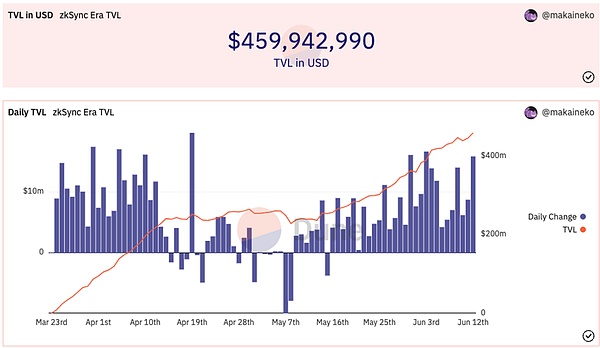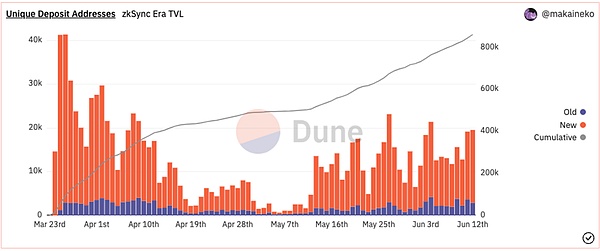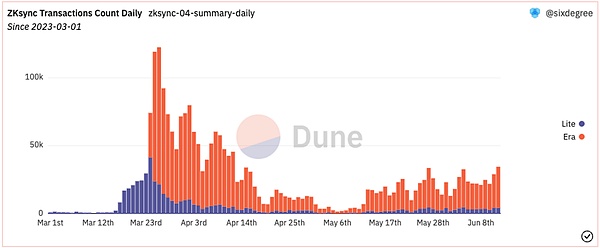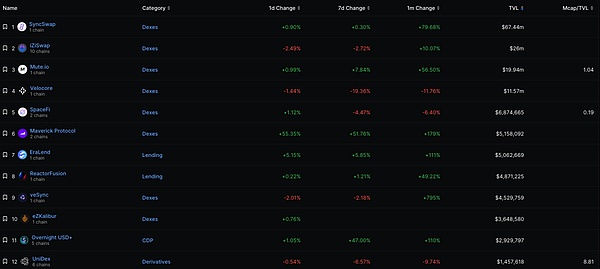The Ethereum Layer 2 expansion mechanism is a well-known concept in the blockchain industry and a battleground for everyone. This article will introduce zkSync, the first Layer 2 network to use zk-rollup technology on the mainnet, from the introduction of the public chain itself to the development of ecosystem projects, and provide a comprehensive analysis from the fundamentals, data to the ecosystem.
I. Introduction to the zkSync Era
zkSync is an Ethereum Layer 2 scaling solution based on zk-rollup architecture, aiming to achieve high-performance, low-cost smart contracts and blockchain applications. It uses zk-rollup technology to achieve high throughput scaling, reducing transaction costs and improving confirmation speed. zkSync Era is built on the zkSync protocol and has faster transaction speeds, higher scalability, and more economical and efficient features. It is applied to DeFi, cross-chain bridges, NFTs, and many other fields. Due to its efficiency and low cost, zkSync has received extensive attention from the capital market and is developing rapidly.
Matter Labs, the development company behind zkSync, has completed a total of four rounds of financing, with a total financing amount of US$458 million. Well-known venture capital firms such as a16z, Dragonfly, 1KX, OKX Ventures, bybit, and Blockchain Capital have participated in the investment. Looking back, this financing amount is a notable amount in the WEB3 or WEB2 field, and is a leading unicorn project in the blockchain industry.
- Understanding Uniswap V4: Cost Reduction and Efficiency Enhancement, Personalization and Aggregation
- Leading the way in analyzing the zkSync Era scaling solution for zero-knowledge proofs
- Understanding EigenLayer’s Features and Future Plans in One Article with the Launch of Its First Stage on Ethereum Mainnet
With strong financing background, cutting-edge technology, and being the first batch of players in the zk-rollup technology that Ethereum founder Vitalik once praised, zkSync Era is one of the top performers in the narrative, capital, and actual aspects. The desire of the blockchain world to pursue new things also makes zkSync Era the most eye-catching and hottest public chain in 2023.
zkSync Era History
-
zkSync 1.0 – zkSync Lite launched on the Ethereum mainnet on June 15, 2020, achieving a transaction throughput of about 300 TPS, but it is not compatible with EVM.
-
zkSync 2.0 – zkSync Era launched on March 24, 2023, supports any smart contract function implemented in Solidity (via zkEVM) and Zinc (the internal programming language of rollup). Secondly, through zkPorter – a protocol that combines zk-rollup and sharding, the throughput increases exponentially to over 20,000 TPS.
The biggest selling point of zkSync Era compared to zkSync Lite is compatibility with EVM. It can execute smart contracts written in Solidity or other advanced languages used in Ethereum development, which can attract more developers and users to seamlessly connect to the ecosystem. In addition, the transaction cost has been reduced by 50 times compared to before, and the speed of 20,000 TPS makes the user experience better in the long run compared to Ethereum itself or zk lite.
zkSync’s competitors
zkSync’s competitors are undoubtedly various public chains in the L2 track. In addition to the mature and leading Arbitrum One & Optimism, many latecomers using zk-rollup are the opponents that zkSync needs to pay more attention to:
Including the already launched Polygon zkEVM, the well-known and heavily invested Starkware, Linea developed by Consensys, Scroll, which is also committed to developing zkEVM, and Aztec, which focuses on privacy, are two Layer 2 solutions sponsored by exchanges, Taiko invested by OKX, and Mantle developed by Bybit. Even the already launched Optimistic Rollup Metis has announced that it is actively developing Hybrid Rollup by combining zk-rollup with the current Optimistic Rollup. Finally, there is Kakarot, which has attracted attention due to Vitalik’s personal investment in the Pre-Seed round.
zkSync currently occupies a 100% advantage in the pioneer, how to continue to lead and bring users a good experience in the future, besides the technical aspects, how to cultivate the ecology is the most important thing.
II. zkSync Era data overview
Before introducing the ecological project in detail, let’s first look at the data such as TVL, official bridge in and out, and daily on-chain transaction volume to better understand the current status of zkSync Era ecology.
From the on-chain TVL data, the total TVL of zkSync Era ecology reached 459 million US dollars in just 2 months after its launch. It has maintained stable growth in TVL since its launch and currently ranks third in Layer2 Rank, second only to Arbitrum One & Optimism that uses Optimistic Rollup.

source: l2beat.com/scaling/tvl

source: dune.com/makaineko/zksync-era-airdrop-criterion
According to official bridge data from zkSync Era, the number of cumulative deposit addresses has reached 800K, with an average of around 10K new deposit addresses per day since June.

source: dune.com/makaineko/zksync-era-airdrop-criterion
On the other hand, looking at the daily transaction TX volume of zkSync Era, it has fallen from its peak of nearly 100K transactions per day at the beginning of its launch to a low point of only 1,300 transactions in early May. It is currently steadily increasing and maintaining around 20K transactions per day. The reason may be that there are currently no killer DAPPs on zkSync Era, and the increase in transaction volume at the beginning was only due to novelty.

source: dune.com/sixdegree/zksync-airdrop-simulation-ranking
In summary, the ecological situation is still in the early stage, having only been launched for less than three months, achieving such results is not easy. After passing the early FOMO stage, it is steadily rising, and it is expected to break through with more project deployments on the chain in the future.
III. Introduction of zkSync Era ecological projects
Old projects
zkSync Era received promises from many projects to deploy before it was launched, including Balancer, Uniswap, Frax, OHM, LayerZero, and other well-known protocols on the mainnet, but there are not many completed deployments. Currently, the largest old protocol that has been officially launched is 1inch and iZUMi Finance.
1inch Network
The 1inch aggregator is one of the cornerstones of Defi projects. It officially landed on zkSync Era on 4/20 and became the 11th deployed public chain. With 1inch, the liquidity split on the chain has a good entry point, and users no longer need to consider which DEX to operate when exchanging tokens, effectively promoting the ecological development.
iZUMi Finance
iZUMi is also a Defi project deployed on multiple chains. It was deployed at the beginning of zkSync Era’s launch and is one of the first and most active old protocols to deploy on zkSync Era. iZUMi’s TVL on zkSync Era is quite impressive, currently ranking second on the chain and becoming a strong competitor in the zkSync Era DEX track.
From TVL perspective, zkSync Era is a top project

source : https://defillama.com/chain/zkSync Era?tvl=true
It can be seen from the statistics of Defillama that the development of the chain is very early. The top five locked positions are all DEX decentralized exchanges, and eight of the top ten are DEX projects. The remaining two are lending projects. More complex areas such as derivatives and GameFi still have no strong competitors. The following are the projects classified by category.
DEX Decentralized Exchange
SyncSwap
SyncSwap is a decentralized exchange built on zkSync Era. It has the characteristics of low transaction cost and inherits the complete security of zkSync.
SyncSwap’s functions include supporting pool meters (gauges), custom fee structures, advanced routers, voting trustees token model and governance, etc.
Recently, SyncSwap launched the cross-chain bridge Move based on zkSync Era’s official bridge, allowing transfers between Ethereum and zkSync Era, supporting multiple assets such as USDC, ETH, USDT, WBTC, LUSD, LSD, MUTE, etc. In fact, Move can be understood as a third-party front-end for zkSync Era’s official bridge, with the same gas cost as zkSync’s official bridge. The bridged tokens are 100% zkSync native assets without third-party risks. When a user approves or transfers with Move, it directly interacts with the official zkSync smart contract.
iZUMi Finance
iZiSwap is a chain order book DEX launched on zkSync Era by iZUMi Finance, a one-stop liquidity-as-a-service DeFi protocol, using iZUMi’s discrete liquidity AMM (DL-AMM), similar to Uniswap V3 centralized liquidity, DL-AMM can allocate liquidity to any fixed price, improve capital efficiency.
iZiSwap is a continuation of automatic market maker (AMM) DEX represented by Uniswap. Its innovative design not only improves the efficiency of liquidity supply, but also greatly enriches users’ trading experience, making iZiSwap stand out in the competition of decentralized trading platforms.
It is worth mentioning that iZiSwap has launched a completely decentralized limit order book mode. During the transaction, all limit orders on a single point are treated as a whole. This approach can greatly improve the efficiency of transactions and ensure that transactions are completed in O(1) time. Secondly, whenever the price crosses a price point, the amount of orders traded will be transferred to an independent storage space called legacy. This design enables the system to clearly distinguish the order of orders, ensuring the correctness of transactions.
Finally, users need to claim the traded assets themselves. This is a necessary restriction because it ensures that users have complete control over their assets and avoids security issues that may arise from automatic asset transfers.
Such a design brings a range of good characteristics. First, since limit orders on a single point are treated as a whole, transactions can be completed in O(1) time, greatly improving transaction efficiency. Secondly, when the price crosses the target price (time point A), then falls back (or crosses) the target price again (time point B), the limit orders after time point B are not recorded as traded, which ensures the correctness of the transaction. Finally, when the price is on the target price, the part of the transaction that is executed is obtained by the user who first initiated the claim operation, which ensures fairness in the sense of first come, first served.
Overall, iZiSwap’s innovative limit order management approach brings significant improvements in security, efficiency, and fairness, and provides users with a better trading environment.
Maverick Protocol
Maverick Protocol is a DeFi liquidity infrastructure designed to provide a liquidity market for traders, liquidity providers, DAO funds, and developers, supported by Maverick AMM.
Users can trade and provide liquidity on Maverick AMM. There are four different types of liquidity modes: Mode Right, Mode Left, Mode Both, and Mode Static. After choosing a mode, the AMM will automatically move its liquidity to follow the price according to a set of specific rules. Maverick Protocol allows LPs to open Boosted positions, using incentive rewards to precisely attract liquidity, and other users can add liquidity to the Boosted position to buy shares. LPs can earn income from transaction fees and LP incentives.
Mute
Mute.io is a DEX based on zkRollup on
SBlockingceFi
SBlockingceFi is a Web3 platform that connects the Cosmos ecosystem with Ethereum Layer 2. Its products include DEX, NFT, Starter, SBlockingcebase, and there will be new products like Game and Social Network in the future. SBlockingceFi supports trading and adding liquidity with ETH, USDC, SBlockingCE, and WETH tokens. Users can participate in mining by staking single coins like xSBlockingCE and LP tokens like SBlockingCE-USDC in the SBlockingce farm to earn xSBlockingCE rewards. Starter is the incubation and fundraising platform of SBlockingce. Users can pledge USDT, ETH, or LP tokens like SBlockingCE-USDC to get shares of the project tokens at the initial issue price. SBlockingcebase is the on-chain community of SBlockingce. Users can create or join SBlockingcebase to earn more mining rewards. Planet NFT is minted by SBlockingCE tokens. NFT holders can propose on-chain proposals, and both Planet NFT holders and xSBlockingCE holders can participate in governance voting.
Velocore
Velocore is the first ve(3,3) DEX based on Velodrome Finance and Solidly codebase on zkSync Era. Velocore’s core function is to allow users to trade digital assets at low cost and low slippage. Users can add liquidity to LP pools (divided into Stable Pool and Volatile Pool) and use LP tokens to get VC token incentives. VC is the native token of Velocore. VC holders can vote to delegate tokens and exchange governance tokens veVC (veNFT). veVC can be transferred, merged, and split. The lock-up period of VC can be as long as 4 years, and the longer the release time, the higher the voting weight and reward that veVC holders can get. veVC holders can also get protocol fees, bribes, and kickbacks. Bribes can be used to encourage other users to vote for LP pool rewards. Velocore also has LaunchBlockingd and launched memecoin WAIFU.
veSync
veSync is also a ve(3,3) DEX on zkSync Era, and it is also a fork of Velodrome Finance. The TVL of veSync on zkSync Era is about 4.85 million U.S. dollars, ranking seventh, with an increase of nearly 20% in the past 7 days. The native token of veSync is VS, and the governance token is veVS (veNFT), which can be transferred, merged, and split. veSync uses the ve(3,3) incentive model. Token holders can vote to delegate their tokens to receive veNFT, and longer ownership periods will bring greater voting rights and rewards. veSync liquidity pools are now divided into Stable Pools and Volatile Pools, and the transaction fee is 0.02% to 0.05%. In the future, veSync will launch Concentrated Pools, allowing users to customize the liquidity range provided. Users choose a specific pool to participate in voting and receive bribes.
eZKalibur
eZKalibur is a new DEX that just went live this week. It raised a total of 653 ETH during the token fundraising phase. Based on Arbitrum’s top DEX Camelot, the fork project adopts a special token lock-up dividend mechanism similar to Camelot xGrail. It also has the function of lauchBlockingd. As the project has not been online for long, security risks should be noted.
Lending Market
Lending has always been the most important infrastructure in various public chains besides DEX. However, because Chainlink has not yet been integrated into zkSync Era, and currently uses Redstone Finance’s oracle, whale users dare not use it. In addition, there are only two major assets, ETH and USDC, in zkSync Era, and there are not many real-world use cases. Therefore, the lending field is a lukewarm existence in zkSync Era, and most users may be bear hunters or DEFI farmers.
Eralend
Eralend, formerly known as nexon finance, is the same as ReactorFusion, both of which are compound fork protocols. In terms of mechanism, there is no great innovation. The project was mentioned in the official Twitter introduction of the ecological project of zkSync Era, and the protocol has not issued governance tokens, which may have attracted a large number of bear hunters to participate. The current TVL is comparable to that of ReactorFusion, both of which are $5 million and are the top lending markets in zkSync Era.
ReactorFusion
ReactorFusion is the first project launched by velocore lauchBlockingd. The protocol itself is a compound fork and a unique bribery reward token mechanism. Its token ecology is highly tied to velocore, and the current TVL scale is about $5 million.
CDP Overcollateralized Stablecoin
Overnight USD+
Overnight is a multi-chain project that started with Polygon and currently supports five public chains, including Polygon, BSC, OP, ARB, and zkSync Era. It is also one of the few protocols that quickly cross-chain deployed when it went online in zkSync Era. Its main products are the revenue stablecoin USD+ linked to USDC and the delta-neutral revenue-generating strategy treasury ETS. The project has been online for about a year, and the team is relatively reliable, suitable for DEFI farmers pursuing high stablecoin income.
Derivatives
Unidex
Unidex is also a multi-chain deployment project, with its main product being a decentralized perpetual contract exchange. Its feature is that it can integrate the depth of other perpetual contract exchanges and provide functions such as limit order take-profit and stop-loss. In addition to trading cryptocurrencies, it also includes commodities such as US stocks and foreign exchange. It is an on-chain perpetual contract aggregator, and other products include spot trading aggregators, limit orders, and other functions.
Other projects
Kreatorland
Kreatorland is an Opensea Fork on the zkSync Era chain that provides a one-stop NFT project. It is one of the projects mentioned in the zkSync Era official Twitter post, providing users with the service of minting and issuing NFTs. It also has a launchBlockingd and a trading market, but currently only one NFT, Poop Genesis, is listed.
Goal3
Goal3 is a gaming platform project on the zkSync Era chain, and it is also one of the projects shared by zkSync Era officials. Its token $ZKG Lockdrop attracted a total of 2.8 million USDC to participate, and the addresses locked for one year accounted for nearly 50% of the total. The funds locked in the Lockdrop activity are used as depth for the gaming market. The beta version of the project has been launched, and users can place bets on various sports events on this platform.
Summary
zkSync has a rich development history and a promising future. With the continuous advancement of Ethereum technology, competition in the zk-rollup or zk-EVM field is also intensifying. zkSync Era occupies the leading position and can establish the ecosystem first. Currently, both the data and the overall ecosystem have proven that the zkSync Era public chain is in a stable and rising stage.
From the number of protocols, it can be seen that the DEX track is the most maturely developed in the zkSync ecosystem. Whether it is the traditional Uni v2 fork, ve(3,3) solidly fork, or centralized liquidity DEX, they have achieved outstanding results. However, lending, derivatives, NFT, or GameFi tracks have not had any innovative applications that can attract users. It is expected that with the deployment of more infrastructure projects, including cross-chain protocols, oracles, and stablecoins, there will be more interesting Defi Lego projects.
At the same time, it is worth noting that while the ecosystem is thriving, various Rug Pull incidents also occur frequently, and there have been cases where user funds were locked due to code compatibility issues. Participants in the ecosystem should pay attention to various considerations such as the background of the project party, but new things represent new opportunities, and participating more in the ecosystem may discover early high-quality projects.
Like what you're reading? Subscribe to our top stories.
We will continue to update Gambling Chain; if you have any questions or suggestions, please contact us!